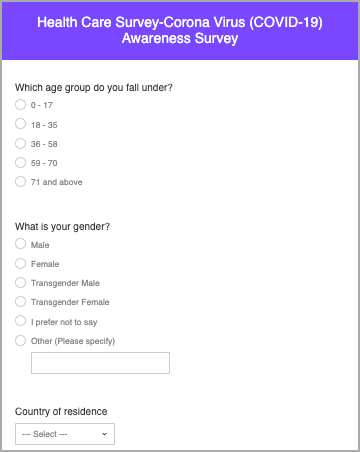- HOME
- Best practices
- Covid-19 resources
- Redesigning your market research during COVID-19
Redesigning your market research during COVID-19
- Last Updated : August 12, 2024
- 266 Views
- 8 Min Read
Almost a year into the pandemic, consumer behaviors are now settling into a new normal as people everywhere learn to live with the presence of COVID-19, and many countries start to re-open their economies.
The prevalence of work-from-home policies and the adoption of new technologies across many sectors are a marked result of our current world. Consumers are deeply concerned about the long-term impact of the virus, both from a health and economic perspective. People’s attitudes, behaviors, and buying habits are changing, and many of these changes will remain even after the pandemic. Social distancing has also led to a surge in digital commerce.
Amid shifting consumer sentiments, a critical question on every marketer’s mind is:

The COVID-19 pandemic will result in a long-term psychological shift in how we view many things, and marketing is no exception. This makes it imperative for businesses to lead with sensitivity and foresight, and they must adapt to change in order to win the consumer’s trust.
Now more than ever, marketers will need a proactive plan to adjust how they lead their teams, speak to their customers, and manage their brands.
To get the ball rolling for your market research, you need at least a basic idea of what the consumer may be going through during this pandemic.
Data and insights can be highly reassuring in critical moments, with surveys being essential in gaining a real-time view of current and evolving consumer attitudes. Consumer surveys provide information on what’s going on in the minds of a huge number of people. This pool of data, when sampled by markets and regions alongside analytics, has the potential to paint a clear “before and after” situation.
Here are some of the changes that may be affecting your buyers’ sentiments and have the potential to give a new approach to post-covid marketing.
Shifts in consumer sentiments
Your customers are more conscious
Consumers are expecting a higher level of mindfulness and sensitivity from brands, preferring they address the larger issue rather than be opportunistic. Customers pay more attention to how companies are marketing their brand and the values they stand for, and this trend is likely to continue post-pandemic. Instead of resorting to ill-conceived strategies, brands large and small should move towards empathetic communication in a bid to understand the situation their customers and potential customers are facing, thus connecting with them on a deeper level.
Many brands are likely to adopt a “cautiously optimistic” approach that will shape their growth. They also have to come together to put the economy back on track, which may require some level of encouragement towards the consumers.
Some brands are ushering in partnerships with big pharmacy companies who are working to find a vaccine. For example, some cold-chain logistics company or warehouse real estate businesses are teaming up with pharma organizations to ensure an efficient distribution chain for upcoming vaccines. These partnerships not only add to brand reputation, but also build public trust.
Many mid-sized brands are also busy tweaking their business models. A good example could be apps across different sectors, such as ride-hailing and food, expanding into the groceries delivery space across the world. This helps eliminate the great risk of people exposing themselves to the virus every time they go out for essentials.
Responding to the basic concerns of the consumer
Offbeat marketing campaigns should probably take a break right now. Many consumers are craving a return to their normal lives, which includes doing things like eating out, talking to coworkers in person, going to parties, traveling, and attending a concert. These have become pre-COVID era luxuries. Our “new normal,” as it has been described, is aligned more towards the more basic needs of life, personal hobbies and self-improvement, and financial security.
A great priority for health, wellness, fear of unemployment, and disruption in routine caused by COVID-19 has reinforced the idea of “saving for a rainy day” in consumers’ minds and will reflect in their behavior. Brands who tick all boxes, do social good, and win consumer trust in this aspect are more likely to see a rise in demand.
Hope, positivity, and resilience matter more than ever
The post-COVID-19 era will test the resilience of brands and their ability to scale. Those who anchor their communications to positive messaging and hope for the future will win. This is a critical time for businesses to take the pulse of the market and align their strategies quickly.
To achieve all the factors we just discussed, research is critical and should always be the very first step. Understanding what your customers are thinking and feeling, as well as studying what is going on in your industry and in broader society, will help you take the informed path to make better business decisions.
That being said, we also understand that wading through a shifted world means a lot of uncharted territory. That’s why we have come up with the following pointers to give you a good idea of how to interact with your target users in the COVID-19 era.
A new strategy: where to start from?
Be iterative in your research approach
Our environment right now is unknown, so it’s important that we look at survey research as a continuous and ongoing process where the questions asked evolve, adapt, and change from one conversation to another, resulting in layers of insights.
Be sensitive about the questions you ask, and the way you plan to ask them
There are many layers of sensitivity to be addressed when surveying people. Any marketing campaign running right now needs to be sensitive and your research questions need to both empathize with the new careful consumer and give them a reassuring hope of change if answered. With a sudden slump across many industries—especially, entertainment, hospitality, and travel—many people have lost their jobs. Make sure not to ask unnecessary questions and don’t make assumptions about the customer’s experience during the pandemic.
Keep a close eye on your findings
Trending data may change any time due to the extraordinarily volatile circumstances we are experiencing. It is essential to view data in this light and not take results for granted. If you have a iterative process going (check out the first point here), then this will be a lot easier for you.
Get creative with your research
Online Pulse Surveys
Pulse surveys can help you quickly check in on a topic. They can be quickly re-run from time to time as well, this can help you track peoples’ sentiments over certain periods.
For example,
Returning to the workplace may be something that your organization is considering. Sending a return-to-work assessment as a pulse survey can act as a litmus test to see if your employees are ready to come back into the offices.

As a health measure, companies can run a COVID-19 awareness survey to understand knowledge about the virus among employees.

Online focus groups and interviews
While face-to-face meetings may not be an option, it is still possible to have meaningful conversations with people through online focus groups or interviews.
These can help you get an idea of customer sentiment and gauge how they might regard risk-taking during the pandemic, what is compromise-worthy for them, and what is not. Furthermore, it can help you gain valuable customer insights, understand their authentic viewpoints, and hear their stories.
Mobility tracking
Social distancing has caused a great shift from a social, active way of lifestyle to a stationary one. From traveling to multiple places in a day, most employees now exclusively work from home across major cities. You can map this massive shift using mobile ethnography surveys. This is a powerful way to explore how your customers are thinking, feeling, and acting.
Depending on what is relevant to your brand, you may look to how people are adapting to life at home, changes in mealtime patterns, how life may look different in the future, and the overall lessons they have learnt from this pandemic.
While planning any sort of market research on work situations during the pandemic, keep the following practices in mind:
Be crystal clear on why you’re researching this topic and how your data will be used.
Keep the maximum time taken to complete a questionnaire low. We recommend less than 10 minutes, as your consumers’ patience or attention span may be limited.
Do not overburden customers with in-depth research requests, like asking for too many details about the pandemic situation in their area and other things which you think may be outside their knowledge area. Asking too many things may result in them leaving the survey unfinished.
Putting a halt on market research would be a big mistake for any brand right now. With the right survey, reporting, and analytical tools, businesses should improving their research capabilities and studying their market.
While it is true that your consumers may have too much on their plate right now to even be interested in telling you their opinion, you can learn what they are doing if you can reach out to them with the right strategy. And that data is more important now than ever before.
Nations, cities, and towns are reopening across the world at their own paces. Marketers should continue to use data to measure customer and employee sentiment, and use this measure to ensure their brand is communicating the right message to the right audience.


